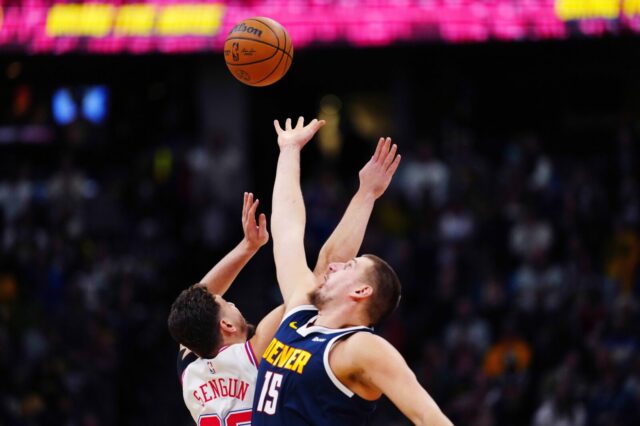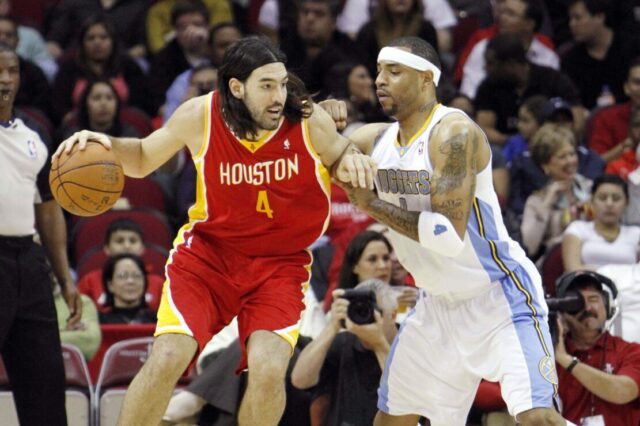Throughout their last ten games, the Denver Nuggets are playing some of the worst basketball in the NBA. Their 2-8 record during that span is tied for 3rd worst, sitting at the bottom with the Thunder, Pistons, and Magic. Their two wins did come against playoff teams on the road beating the Knicks and Heat, but they have not built any consistency following those wins.
Although Nikola Jokic has played well in the two wins since his return, he has not appeared to fully return to form following the wrist injury. Against Orlando, he shot 7-19, in Chicago he shot 6-17 and in both games, he missed several shots you never see him miss. He still maintained a positive plus/minus on those nights because he impacts the game in various ways, but unfortunately, he is positioned as Denver’s savior and has too many responsibilities on his plate. In order to squeak out the narrowest of victories, Jokic needs to be efficient from the floor, initiate offense without turning it over, carry the rebounding duties, and protect the paint. There is not one player in the NBA burdened with all those responsibilities on a nightly basis and it is a major factor in Denver’s decline.
When reviewing their disappointing play of late, it is easy to call for better players, more made shots, and better defense but how do they do that? The Nuggets might make some small changes to bolster their depth but for the most part, this is the roster they will run with. It’s not the deepest of Nugget teams over the years, but this is a roster capable of making a deep playoff run if the role players can enhance their game.
When we look at this underwhelming stretch from a macro perspective, we see glaring deficiencies scoring the basketball and keeping the opponent from doing so. In their last ten games, they hold the league’s worst defensive rating at 117.8 and offer the opponent 112 PPG. Offensively during that span, they are 23rd in the NBA scoring 103.7 PPG and have a plus/minus of -8.3. With that being said, no team would ever find an answer for their struggles if they just focused broadly on scoring and defending better. It has to be more intricate than that and it is.
When I worked to unveil the curtain behind their inadequacies, I saw two major categories. They are losing the paint battle on both ends and they struggle mightily in the second half.
Points in the paint
This might be the most discouraging aspect of this Nugget slump. In their last 10 games, the opponent is scoring about 48.8 PPG (tied for 5th worst) in the paint on average while scoring 112 PPG overall. Offensively, they average 43.5 PPG in the paint which ranks 23rd, but there is a more concerning stat. During December, they are scoring 34 PPG in the paint while giving up 50 PPG in the paint.
During this 2-8 stretch, the Nuggets were outscored nine times in the paint. Even in their wins, they are losing the paint battle but they overcame it by making 18+ threes in those two games. That is not sustainable. Although the Nuggets are shooting better of late, they should not rely on the three-point line for their offense. For the successful teams, points in the paint aid the three-point line and vice versa. For example, the Phoenix Suns shoot the 5th highest percentage from three at 36.9%, and they score the 6th most points in the paint at 48.6 per game. It’s a similar story with the Utah Jazz as well. We think of them strictly as a three-point offense because of their frequent attempts but they are top 10 in points in the paint as well.
I think part of the issue can be attributed to Denver’s lack of aggression towards the paint when the play breaks down. Denver’s half-court offense is more technical than others. They run actions to free an open shooter or capitalize on a mismatch, but once that certain play doesn’t work, Denver often results to the perimeter instead of the free-throw line. The Nuggets rank last in the NBA in free-throw attempts at 16.2 per game. You don't have to be a leader in that category to be successful, which is evident by the fact the Rockets lead the NBA in that statistic, but Denver appears to make the game more difficult for themselves.
Here are some examples of Denver’s difficulty in the paint:
One of the major factors in not being able to guard the paint is granting straight-line drives. The Nugget defense is discombobulated here but we will focus on the matchup between Harris and Barton. So Harris receives the ball in the corner and fakes the shot, influencing Barton to close the space between them. Barton is giving Harris the baseline because he knows he has help. Since Barton is giving Harris the baseline lane, he has to make sure Harris will not penetrate to the other side. Instead, Barton lets him go right by. Harris doesn't even make a move, he just drives right past Barton and since Carter Jr. does a good job of boxing Green out, there is no help to stop the drive.
This is a great example of what the Denver offense looks like in times of despair. Yes, they are down 17 so a comeback is improbable but it becomes impossible when the offense acts like this. Don’t pay as much attention to the score because this is a frequent occurrence in the Denver offense just about every game. Throughout this possession, not one person touches the paint until a shot goes up. Instead of being in attack mode, Denver is in panic mode here. Jokic sends the pass to Gordon and without thought, puts up the three. It is a makeable shot but the defense is actually daring the Nuggets to drive the basketball and they do not. There are no Chicago defenders in the paint and if Gordon forced a drive, he would either have an isolation in the paint or force a double team and kick it out for an easier three-pointer.
The Nuggets want to become more of a perimeter, three-point offense which is fine considering that is where most of the NBA is leaning towards. The issue is, the inside threat creates open threes, and if you convert those threes it opens up the paint. Denver needs to become more diverse in its attack. If Gordon is hot from three, teams will crowd his space to avoid more threes. That being said, if he has success from three, it opens the paint and leaves him open driving lanes but Denver doesn't take those. If they are hot, they keep shooting until they are cold, and if they are cold, they keep shooting until they are hot. It’s not a recipe for success and teams understand how to gameplan for it.
2nd half struggles
This has been a theme for the last couple of years. Denver acquires a lead at half and they do not enter the 3rd quarter with the same sense of urgency. The perfect example manifested itself in Orlando. Denver outscored them by 16 in the first half, then Orlando beat them by 12 in the 3rd, and 9 in the 4th. It comes down to a game of adjustments and the Nuggets are not making or executing them. At the end of the first half, Orlando recognized they were not shooting the ball well. In fact, they shot 22% from three but they outshot Denver from the field at 54%. How does that happen? They did not panic, they understood the assignment, and took it to the paint. They demolished Denver 66-38 in the paint, much of which came in the second half.
In the 3rd quarter of their last ten games, the Nuggets are 28th in scoring at 24.5, and in the 4th quarter, they score even less with 23.6 points. If we look at second-half scoring in their last ten, they are second last at 48.1 points per game, just .1 points better than the 4-19 Pistons. In the first half, they score 55.6 per game (11th) while shooting 48% from the field (6th), and 40.2% from three (4th). In the second half, those percentages decrease to 42.8% from the field and 34.7% from three.
There are several reasons for the lack of production in the second half, but I would like to point out the shot selection. The Nuggets are successful in the first half, in part, because there is no need to panic and they execute the plan. In their last ten, Denver shoots 40% from three in the first half yet they attempt only 17 threes on average which is 17th in the league. In the second half, they shoot 34.7% but they attempt the 4th most threes at 19.3 a game. So we can piece together the fact the more they shoot, the less they make.
As I analyzed further, I looked at their particular shot selection. Again I looked at their last ten games and found during the first half, the Nuggets attempted 142 shots within 5 feet and are shooting 61.3%. In the second half, they have only attempted 99 shots within 5 feet and shot 58.6%. So not only are they shooting less in the paint but they are also converting at a lesser mark as well.
Furthermore, they shot 5 more threes in the second half but they are seven percentage points worse in the second half. The Nuggets like to play ball-movement offense and are successful when doing so and when they don’t, they struggle. In the first half, Denver has assisted on 136 field goals but in the second, that number drops to 114. Without going into too much detail, the Nuggets attempt more cutting and driving layups in the first half. While in the second, they attempt more jump shots, more stepbacks, and more fadeaways.
This is one of those shots where it’s great if you make it but terrible if you miss it. Campazzo slings it to Bones with 13 seconds left on the shot clock, so there is plenty of time to facilitate offense but he chooses otherwise. JaMychal tries to give him a screen but he completely ignores it and fires a tough three. If you look at the Mavs personnel, you see they have no bigs or rim protectors. When you look at the Nuggets, they have two bigs on the floor, one at 6’8” and the other at 7’2.” Again, nobody creates a presence in the paint. Bol is defended by a guard/wing and he stands in the corner, JaMychal also has a guard on him and he does not post up.
Teams are daring the Nuggets to score in the paint, especially with Jokic off the floor. They are subbing in a small-ball lineup because they know Denver won’t hurt them inside. The constant three-point attempts are playing into the opponent's hand. The further the game goes, the tougher it is to make shots as defenses intensify their protection. The great teams notice this and pressure the defense by attacking. Throughout this stretch, Denver has been extremely predictable and the opponents do not fear them at all. The Nuggets appear to be playing stubborn basketball at the moment, avoiding adjustments and just hoping for the best.
The famous martial artist Bruce Lee challenged us to “Be like water.” To not be rigid in mind and body but to be flexible and adapt to the circumstances at hand. The Nuggets need this quote tattoed on each of their foreheads right now. If the threes are not falling, drive to the basket several times to create open three-point attempts. If points are difficult to come by, get to the foul line and slow the game down. Adapt is the keyword for Denver this week and beyond.


